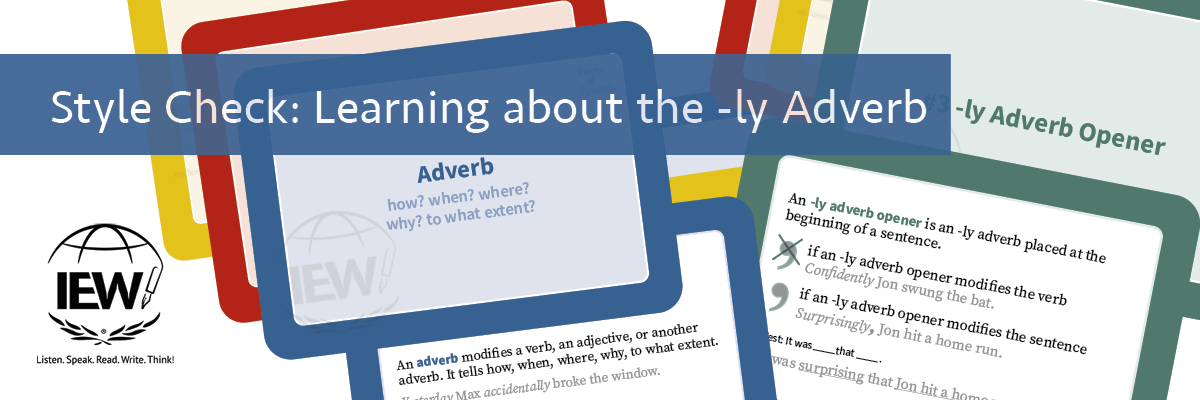
In IEW’s list of stylistic techniques, the first dress-up students learn and practice is the -ly adverb. One of the eight parts of speech, adverbs modify (add information to) verbs, adjectives, or other adverbs within a sentence. Adverbs answer the questions how, when, where, why, or to what extent. Although some adverbs do not end in -ly, the IEW checklist focuses specifically on adverbs that end in -ly.
A well-placed adverb creates a strong image or feeling for the reader to better visualize what is happening within a sentence. Inserted as a mid sentence dress-up, the -ly word is underlined. Consider this sentence: The child walked to his room. Depending upon the -ly adverb selected, different imagery and emotions are evoked. Here are a few possibilities.
The child angrily walked to his room.
The child excitedly walked to his room.
The child leisurely walked to his room.
In each of these instances the -ly adverb describes how the child walked.
By the way, simply because a word ends in -ly, it does not mean that the word is an adverb. There are several -ly impostors that are actually adjectives. Some examples include lovely, chilly, lonely, and ugly. To test whether or not an -ly word is an adjective, apply the adjective test. Insert the suspected word into this phrase: the __ pen. If the phrase makes syntactic sense, it is an adjective. The following examples show that these words are adjectives.
the lovely pen
the chilly pen
the lonely pen
the ugly pen
While students initially learn to insert an -ly adverb as a dress-up, they will later learn to use it as a sentence opener. The -ly adverb opener is indicated with [3] at the beginning of the sentence for a typed paper or marked in the margin of a handwritten paper. When the -ly adverb opener is taught, so is the comma rule.
Here’s the rule. If the -ly adverb opener modifies the sentence, use a comma. If the -ly adverb opener modifies the verb, do not use a comma. The next question that typically arises is “How do I tell whether the -ly adverb opener modifies the sentence or the verb?”
Fortunately, there is an easy way to test it: It was ___ that ___. Reassemble the sentence so that it fits this model: It was (insert adverb in its adjective form) that (complete the sentence).
Let’s practice.
Hungrily she devoured the bread.
Test it: It was hungry that she devoured the bread.
The sentence doesn’t make sense. In this example hungrily modifies the verb devoured, not the sentence. Do not use a comma.
Fortunately, plenty of loaves of bread remained.
Test it: It was fortunate that plenty of loaves of bread remained.
The sentence makes sense because the adverb fortunately is modifying the sentence. Use a comma.
Sometimes the author determines if the -ly adverb opener modifies the sentence or the verb. In those cases the sentence makes sense in either situation, but the meaning changes.
These two sentences illustrate this advanced concept.
Regretfully, the student turned in her homework assignment late.
The -ly adverb opener modifies the sentence. The comma indicates that it was regretful that the student turned in her homework assignment late.
Regretfully the student turned in her homework assignment late.
The -ly adverb opener modifies the verb. Without a comma the -ly adverb opener indicates that the student turned in her homework assignment late in a regretful manner.
The presence or absence of the comma changes the meaning.
Are you interested in learning more about -ly adverbs? IEW has several resources that will support you as you teach your students. Fix It! Grammar is IEW’s award-winning grammar program. Tucked within the Teacher’s Manuals for that course is the Fix It! Grammar Glossary, a fabulous resource for all of your grammar musings. Additionally, you may want to consider adding IEW’s Fix It! Grammar Cards, a fabulous, full-color, glossy set of grammar cards that includes a digital list of engaging grammar activities and games to help cement the learning.
To make accessing -ly adverbs easier for your students, take a look at A Word Write Now, IEW’s thematic thesaurus that features a plethora of words for students to select from. For those students more digitally minded, IEW also offers an IEW Writing Tools App. Finally, check out Portable Walls for Structure and Style Students, a personal-sized desk resource with word lists as well as other writing supports, which makes selecting the perfect dress-up accessible and fun for students.
